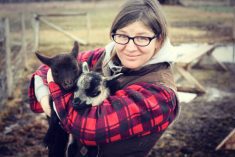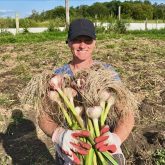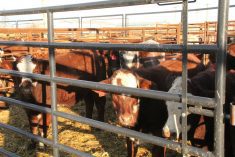Thomas and Felicity Hagan of Oak Lake are the latest beef producers in the spotlight for their focus on the environment.
The Hagans have been named to The Environmental Stewardship Award (TESA) for Manitoba this year. The award, offered locally through the Manitoba Beef Producers, recognizes a beef operation that goes, “above and beyond standard industry conservation practices,” and sets, “positive examples for other cattle producers and the general public.”
Provincial winners are then bound for the national competition, put on through the Canadian Cattlemen’s Association every year.
Read Also

Pig transport stress costs pork sector
Popular livestock trailer designs also increase pig stress during transportation, hitting at meat quality, animal welfare and farm profit, Agriculture and Agri-Food Canada researcher says
“They just really fit the bill,” Manitoba Beef Producers general manager Carson Callum said. “They’re really good stewards of the land, both Thomas and Felicity, and they just were great applicants. They’re doing a lot of responsible things on the land to maintain it for future generations and maintain it for habitat for various species.”
It is not the first time that the family’s environmental efforts have nabbed them an award. In 2017, two generations of Hagans accepted the National Blue-winged Teal Award, as chosen by the North American Waterfowl Management Plan Committee. American, Canadian and Mexican producers are all eligible for that international award.
In that case, Thomas and Felicity Hagan — along with Thomas’s parents, brother and brother’s family — were nominated by the Manitoba Habitat Heritage Corporation (MHHC). MHHC CEO Tim Sopuck singled out the family’s sheer number of conservation easements, including all 3,200 acres of Thomas and Felicity’s land.
About 2,600 acres of that land are able to be grazed, while the remaining land is wetlands.
The pair stepped aside from their family’s performance and ranch horse business this year to put more focus on beef. In 2017, the pair started their own brand, Naturally Manitoba. The vertically integrated enterprise direct markets grass-fed beef to customers.
The pair’s conservation practices orient around grazing. The farm hopes to eventually graze nine months every year, although Thomas says that goal is still a work in progress.
The couple looked to double down on their existing adaptive grazing plan this year, jumping up their stock density after years of rotational grazing. The Hagans have typically moved their cattle one or two times daily, followed by a period of rest for those intensively grazed paddocks. The practice has been linked to increased biomass growth, soil organic matter, water infiltration, soil structure, weed control and other land improvements.
“The main thing we see in terms of production is just far more growth than we had before,” Thomas said.
The couple said they have noted increased root growth, forage quantity and water infiltration in the two to five years since they introduced intensive grazing on various pieces of land.
This fall, the pair increased herd movements to four times a day, with a larger paddock to tide the herd over at night.
The pair also recently benchmarked their soil health in an effort to better track soil changes. In 2018, the Hagans tested some of the worst land on their farm (soil tests that came up with anywhere from 1.4 to 1.6 per cent organic matter) and say they plan to test every five years to compare.
The nuts and bolts
“The basic theory that we turned to was, we graze for performance on the land and the animal during the growing season. We don’t get nearly the amount of animal units, because we’re kind of taking the best part of the plant and leaving the rest,” Hagan said. “Whereas, in the fall, we weaned the calves and we went for land performance.”
The couple’s fall grazing plan instead looks for maximum utilization, he said. Every stalk and leaf in a paddock is targeted, and the couple looks to leave as little forage behind. Protein supplements are also provided for nutrition.
“We’re constantly balancing animal performance and land performance, because if you did that all summer, you wouldn’t get any performance out of your animals and they wouldn’t rebreed, or if they were yearlings, you wouldn’t get any weight gain,” Hagan said.
Even so, he admitted, the system puts a strain on the less hardy of the herd.
Genetic selection has helped the Hagans tailor their herd to their chosen system. Both breeding and culling decisions are oriented around developing a herd that can thrive under that leaner feed. Black Angus is the predominant breed, although Hagan says he has added some Charolais genetics as well. In the future, Hagan said they plan to turn to artificial insemination to bring in yet more selective genetics from other breeds.
The pair’s grass-fed beef enterprise has also provided a much-needed means of profitably marketing culls, he noted. The Hagans’ open rate is perhaps higher than conventionally desired, coming it at around an 86 per cent conception rate. At the same time, Hagan noted, the farm’s cost per cow is way down, while forage quantity is on the rise year after year.
The cost of capturing those last few per cents may not be worth the cost, he argued.
“If you got a 95 per cent conception rate, how many days did it take you to get it?” he said. “If it took 90 days, then I probably am getting that.”
The Hagans preg check at 90 days, only capturing cattle bred in the first 60 days of the breeding season, and many of those “open” cows would likely have calved later, Hagan argues.
In the Hagans’ quest for efficiency however, those late breeders are sold and replaced. Rather than simply cull, however, the Hagans might still look for a premium from those cows by finishing them as grass-fed beef, assuming they are still young, Hagan said. Alternatively, the couple might put the bull back out with those open cattle, and then sell those animals as bred cows.
“It’s really tough to ruthlessly cull if you don’t have a really good way to cull those animals profitably,” he said. “To just simply pull your bulls at 45 days and sell the opens when they’re worth 70 cents (per pound), it’s a really tough way to make a living, especially if you’re planning on pushing them nutritionally and you have a high cull rate.”
The Hagans will present their farm practices at the TESA national event, held during the Canadian Cattlemen’s Association’s semi-annual meeting in Penticton, B.C., in August.




















